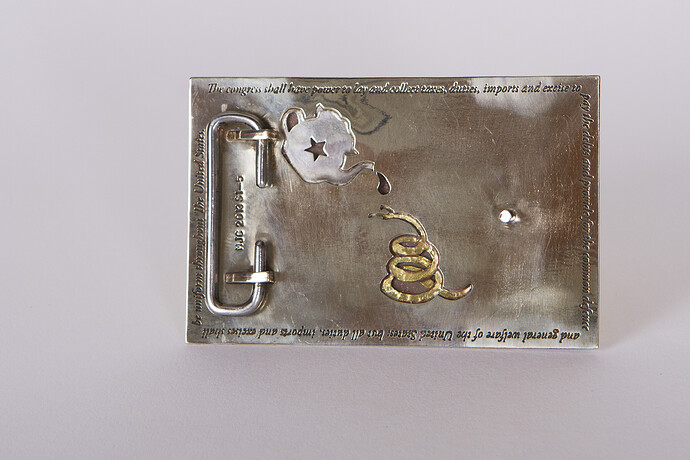Materials: Copper, Nickel Silver, Brass, Sterling Silver, RG-45 Mild Steel, Lead-bearing Enamel
Dimensions: 4.25" L X 2.75" W
A belt buckle talking about the issues surrounding the infamous Tea Party. Created using the Champlevé Enameling technique on 14 gauge copper plate etched by a standard Edinburgh Etch formula. The back piece etchings were also created by an Edinburgh Etch while the mechanism and the device were designed and cut by hand. Ninomiya Japanese Lead-bearing Enamel was used (fired at 1390 degrees F) to achieve the best possible color for the piece.
Matthew Coté
Matthew Coté Art and Design
Tacoma, Washington. USA
As a Metalsmith I try and have a direct message with my body of work. My work is a commentary about the current atmosphere within the human condition that surrounds us while many are persuaded by political, religious, or corporate influences. I received my Bachelor's of Fine Arts Degree in Art from Central Washington University in Ellensburg, Washington; while also receiving the College of Arts and Humanities Dean's Award for Excellence in Leadership. I studied Jewelry and Metalsmithing techniques, including methods of design and approach, under Keith Lewis. I am currently teaching classes at the Tacoma Metal Arts Center and furthering my knowledge of the field, and preparing my portfolio for Graduate School applications, while under the guidance of Owner/Operator Amy Reeves.
The exhibition explores metal works whose primary theme is color embraced as their primary visual focus, whether that be using colored materials, exploring creating colored surfaces, or encasing the object in color.
As the world's largest jewelry related internet site, Ganoksin strives to develop exhibitions showcasing work from around the world. This exhibition was open to all metalsmiths, professional and amateur, advanced and beginner.
In total 303 artists contributed 814 show pieces for the permanent online exhibition.
The exhibition was curated by Beth Wicker, President of the North Carolina Society of Goldsmiths in the United States, and Adjunct Instructor at Northeastern Technical College in South Carolina. Director of the exhibition is Hanuman Aspler, founder of The Ganoksin Project, the world's largest internet jewelry site.
Hue is one of the primary properties of color, it refers to the place the color occupies on the visual spectrum. Humans have used hues throughout time, to create cave paintings, to decorate themselves, their clothing and their housing.
Different hues have taken on different meanings throughout time. Gold traditionally has been a color of purity - the metal gold is relatively unchangeable, and the hue of gold has come to stand for gods and goddesses, for royalty, for durability and for purity. Red has often meant love, or passion. Hues often reflect the meaning of the seasons, with pastels referring to spring and the burst of new life after the pale hues of winter. Summer is reflected in vibrant, deep hues, followed by the browning of hues in the fall as plants go to seed and die, and the land turns fallow.
The worth of a hue has often been tied to what is necessary to make the pigment that creates the hue, and the expensive involved in the process. Often created from crushed stones that had to be mined and carried by caravan over thousands of miles, or from fermented roots of plants only grown in certain areas, or the carapaces of rare insects - the creation of hue in a way that could be used by man was an involved and generally expensive process.
In today's world metalsmiths have access to perhaps the widest range of materials and hues in the history of man - and in some of the most affordable ways ever.
This exhibition celebrates hue - color - as an integral, inherent element of the work. We talk of the "richness" of color, and examples of this abound here. One expects hues from the colors of gemstones used in metalsmithing, but we also have hues from some less expected places. Glass enamels are an ancient way of adding color, as are a variety of patinas. Today's artists also use synthetic man-made materials to add color in ways that didn't exist a century ago.
We invite you to enjoy this celebration of hue, and the ways hues and their use have changed over time.
